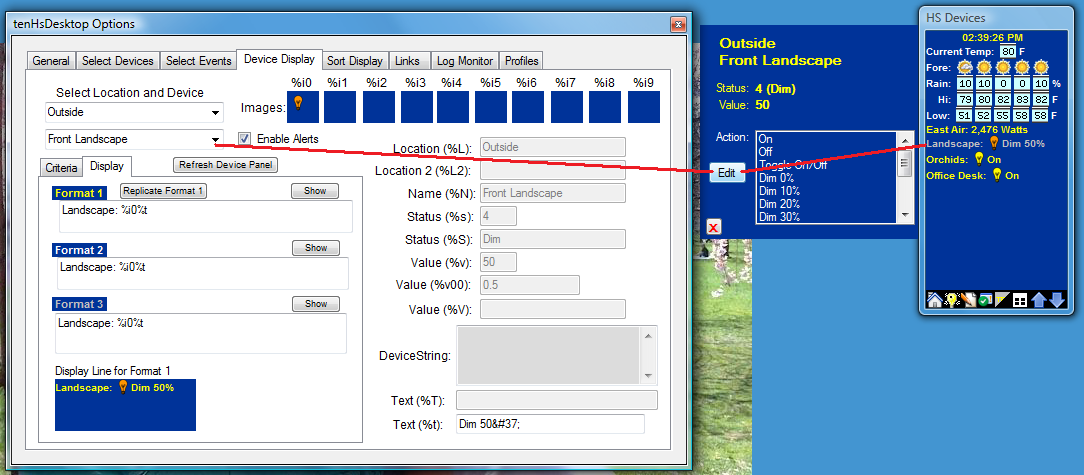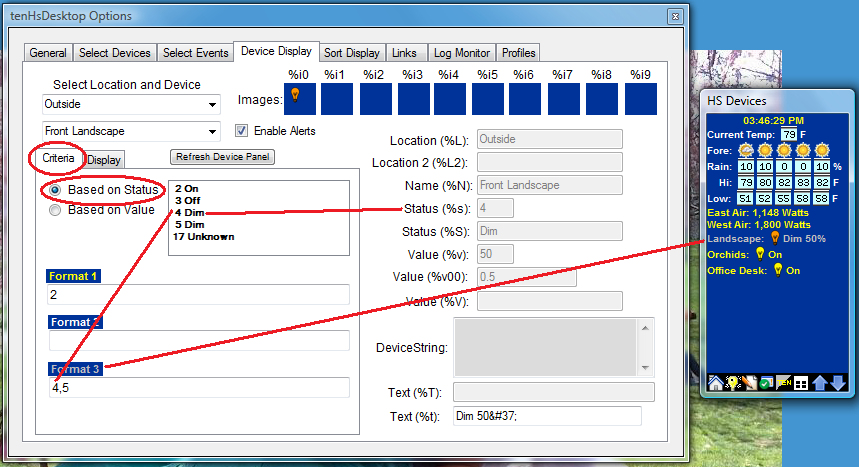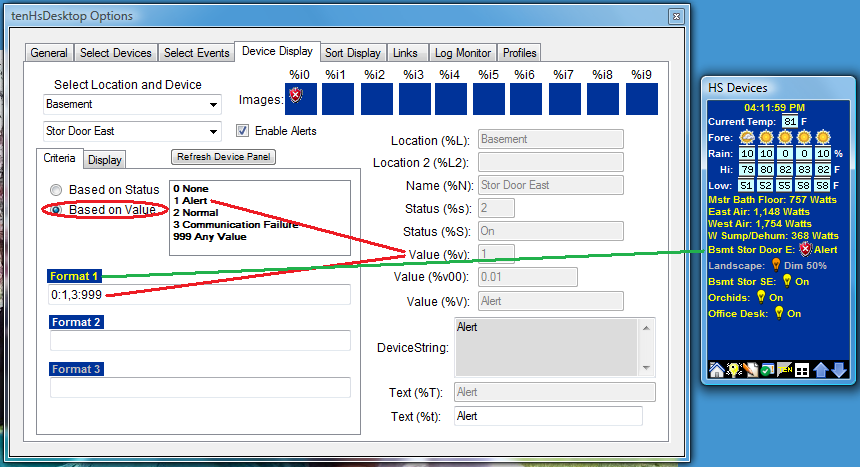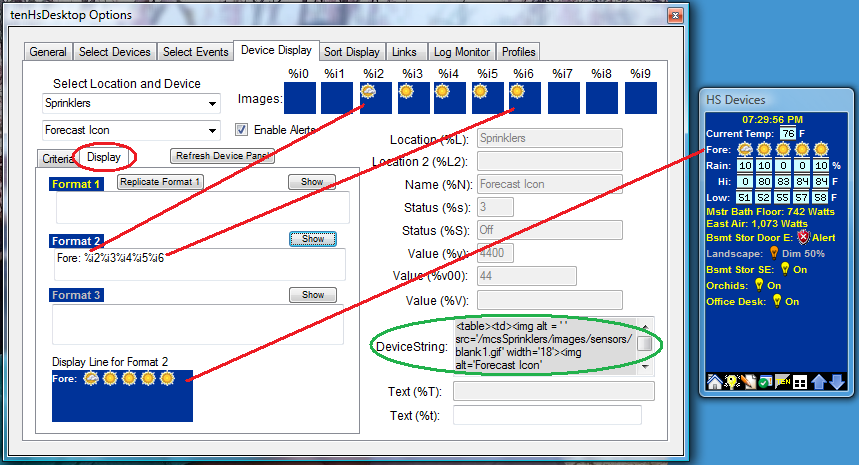tenHsDesktop Configure Device Display
After you have selected which Devices are to be monitored by tenHsDesktop,
you must configure when and how these Devices are to be displayed in the Devices
panel. The default is to display a Device if it's Status is either ON or
DIM. When a Device is displayed in the Devices panel, the default is to
display: (1) it's Name (2) the Text that HomeSeer associates with
the Device, and (3) the Icon that HomeSeer associates with the Device.
Open the Options panel and select the Device Display tab. This can be done by
right-clicking the program icon  and selecting the Options menu item. You
can open the Options panel to a specific Device by left-clicking the Device in
the Devices panel to open the Device Action panel, and then clicking on the Edit
button. Below is the Options panel opened this way:
and selecting the Options menu item. You
can open the Options panel to a specific Device by left-clicking the Device in
the Devices panel to open the Device Action panel, and then clicking on the Edit
button. Below is the Options panel opened this way:

In the panel above, the Front Landscape Device at Location Outside
has been selected, as indicated in the drop-down lists at the top-left of the
panel. You select any Device (that has been selected for inclusion in
tenHsDesktop monitoring) with these drop-down lists. You can also
change the Device selection to any Device displayed in the Devices panel by
clicking on the Device in the Devices panel -- the Device Display
panel will change to that Device. Don't like the way a Device is displayed in
the Device panel? Click on it to open the Device Action panel, click on the Edit
button, and the Options panel will open to the Device Display tab for that
Device.
The left side of the Device Display panel contains controls that are used to
define when and how the Device is to be displayed in the Devices panel.
The right side of the Device Display panel displays the current status of the
selected Device. You specify what is to be displayed by entering the text
you want displayed for each of three different Formats (more on that later).
You can imbed within the display text one or more replacement strings identified
by a leading percent sign (%). The value of these replacement strings will
be inserted into the display text when the Device is displayed in the Devices
Panel. The right side of the Device Display panel shows each of the replacement
strings for the current Device (the values are shown in realtime, and will
change if the status of the selected Device changes). In the panel above, the
display text for Format 1 is: Landscape: %0%t You
can see in the Devices panel that %0 has been replaced with the icon
shown at the top right of the panel, and %t has been replaced with Dim
50% which is displayed as Dim 50%. We'll come back to
formatting the display line.
Setting Initial Default Device Settings
The next sections describe how to configure the display parameters for each
Device. tenHsDesktop initally sets the display parameters for each
Device to a set of default values. The defaults cause a Device to be
displayed if it is ON or DIM and displays the Devices' Name (%N), icon (%i0),
and text (%t). You can globally change any of these values for ALL
Devices to better fit your installation and viewing preferences. First
read the next two sections to better understand how an individual Device is
configured. Before you begin configuring individual Devices, however, you
should globally set ALL Devices' display parameters to ones that fit the
majority of your Devices. Open the Options/Utilities
panel to accomplish this.
Configuring When to Display a Device and Which Format to use
Before configuring the text to display for a Device, you should configure which
of three Formats (or none at all) to use to display the Device. On the
left side of the Device Display panel are two tabs. Select the Criteria
tab to display the criteria for each of three possible display formats:

The Criteria tab is used to specify when to use each of three different
Formats. Format 1 will display the Device's text in
Yellow,
Format 2 will display the text in
White,
and Format 3 will display the text in
Gray.
You specify the criteria for each of the three formats as one or more numbers or
range of numbers separated by a comma. A range is specifed using a colon
(for instance, 5:15). The criteria can be based upon either the
Status of the Device or the Value of the Device. In the panel above, the
criteria is based upon the Status of the Device. tenHsDesktop first
checks the Device's Status or Value against the criteria for
Format 1,
then Format 2, then
Format 3. As soon as a match is found,
that Format is used. If no match is found, the Device is not displayed.
In the above example, Device Front Landscape has a Status of 4
(Dim). The specified criteria is based upon the Device's Status, which is 4,
and therefore Format 3 is used and the Device's display text is shown
with the color Gray.
The actual text used to display the Device is specified using the Display tab
(more on that in a little bit). A list of typical Status values is shown for the
Device. As you change the Format values, you can click on the Refresh
Device Panel button to update the Devices panel and see the effect of your changed
criteria.
You can also base the criteria on the Value of the Device as shown below:

In the example above, the Device Stor Door East is open (a DS10a).
The criteria for this Device is based upon its Value, which is 1 (Alert).
The only format criteria specified is for
Format 1. It specifies to use
Format 1
if the Device's Value is between 0 and 1 or between 3 and
999. Basically, don't display the Device if its Value is 2
(Normal) -- for all other Values display it using
Format 1.
The door is open (Value=1) so it is displayed using
Format 1. A list of typical Values is shown for the Device.
As you change the Format values, you can click on the Refresh
Device Panel button to update the Devices panel and see the effect of your changed
criteria.
Configuring How to Display a Device
After the display criteria has been configured for a Device, you can then
configure how the Device will be displayed. The Criteria tab determines if
the Device is displayed and what color to use to display it. The Display
tab determines what text or icons are displayed. Cllick on the Display tab
to show the following panel:

The Forecast Icon Device is created by the mscSprinklers plugin and
contains icons for the 5-day forecast. The criteria for this device (not
shown here) is blank for
Format 1 and
Format 3, and
Format 2 is defined as -10000:10000 so the Device will always be
displayed as
Format 2. The display text for Format 2 (shown here) is: Fore:
%i2%i3%i4%i5%i6 . The display text contains replacement strings (begin
with %) for images 2 through 6. Replacement strings embedded within
the display text will be replaced with current values from the Device when the
Device is displayed in the Devices panel. You can use any of the following
replacement strings:
%L = Device Location
%L2 = Device Location2
%N = Device Name
%s = The numeric Status of the Device
%S = The text equivalent of the Status of the Device
%v = The Device Value
%v00 = The Device Value divided by 100
%V = The text equivalent of the Device Value (if Value:String Pairs exist
for the Device)
%T = The text portion of the Device's DeviceString
%t = The text that HomeSeer displays for the Device
%i0 = The icon that HomeSeer displays for the Device
%i1 - %i9 = Icons extracted from the Device's DeviceString
In many cases, you will want the same display text for all three Formats
(just displayed in different colors based upon the display criteria). You can
enter the display text for Format 1 and then click on the Replicate
Format 1 button to copy the display text to Format 2 and Format 3.
To see what the display text will look like you can click on the Show
button for any Format and the display text, with substitutions, will be
displayed at the bottom of the panel. Click the Refresh Device Panel
button to refresh the Devices panel to reflect the new display text that you
just entered.
In many cases you will want to enter more meaningful display text than just the
Device Name (%N) that is displayed as default. You may also want to enter
more succint text than the Location and Device Name in order to fit on a single
line in the Devices panel. The display line at the bottom of the panel
(click on one of the Show buttons) is the same width as the current width of the
Device panel to help build a display text that will fit on a single line of the
Devices panel. Its width will change dynamically as you resize the Devices
panel.
You can specify that Alerts should be generated for this Device when its Status,
Value, or DeviceString changes by checking Enable Alerts.